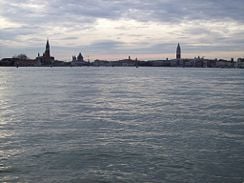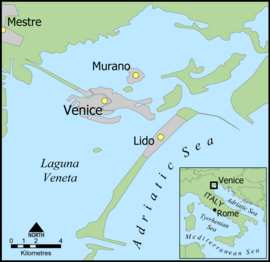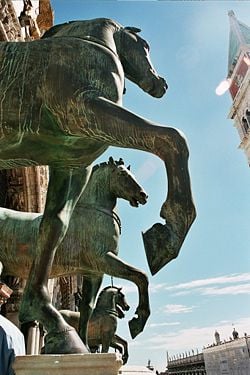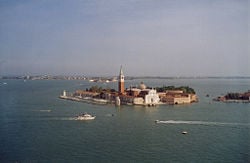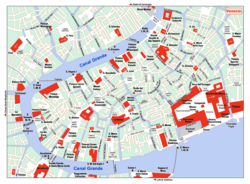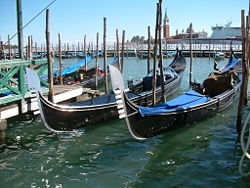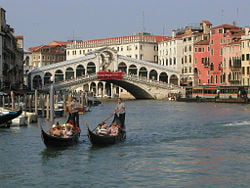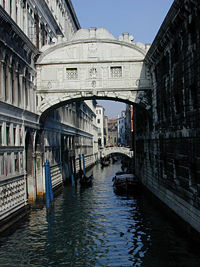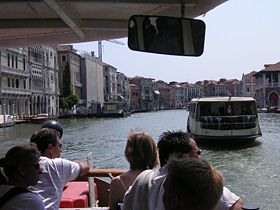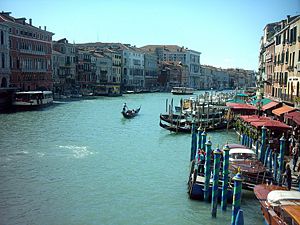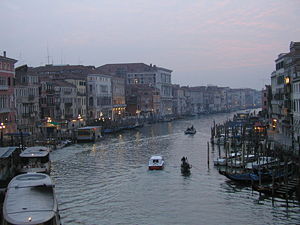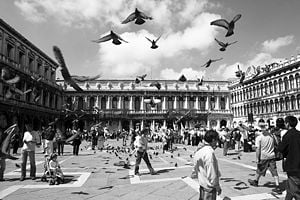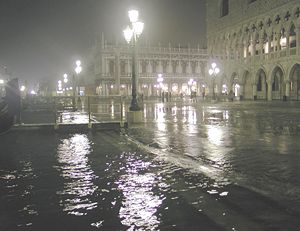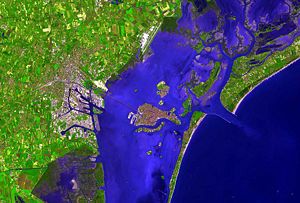| Comune di Venezia | |
|---|---|
 Municipal coat of arms | |
| Country | |
| Region | Veneto |
| Province | Venice (VE) |
| Mayor | Massimo Cacciari (since April 18 2005) |
| Elevation | 0 m (0 ft) |
| Area | 412 km² (159 sq mi) |
| Population (as of January 1 2004) | |
| - Total | 271,251 |
| - Density | 658/km² (1,704/sq mi) |
| Time zone | CET, UTC+1 |
| Coordinates | Coordinates: |
| Gentilic | Veneziani |
| Dialing code | 041 |
| Postal code | 30100 |
| Frazioni | Chirignago, Favaro Veneto, Mestre, Marghera, Murano, Burano, Giudecca, Lido, Zelarino |
| Patron | St. Mark the Evangelist |
| - Day | April 25 |
| Website: www.comune.venezia.it | |
Venice (Italian: Venezia, Venetian: Venezsia, Latin: Venetia) is a city in northern Italy, the capital of region Veneto. For one-thousand years the city of Venice was a politically independent state and a major center of commerce, conducting trade with the Byzantine Empire and the Middle East. The Venetian Republic was a major sea power and a staging area for the Crusades. At the height of Venice's power, its leading families vied with each other to build the grandest palaces and support the work of great and talented artists.
| Venice and its Lagoon* | |
|---|---|
| UNESCO World Heritage Site | |
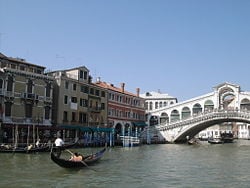
| |
| State Party | |
| Type | Cultural |
| Criteria | i, ii, iii, iv, v, vi |
| Reference | 394 |
| Region** | Europe and North America |
| Inscription history | |
| Inscription | 1987 (11th Session) |
| * Name as inscribed on World Heritage List. ** Region as classified by UNESCO. | |
Today Venice is regarded as an artistic and architectural treasure. Since the end of the eighteenth century, tourism has been a major part of the city economy. The city’s location on a series of small islands in the marshy Venetian Lagoon has limited its physical expansion, and its narrow streets and canals prohibit the use of automobiles. The carefully preserved monuments and fine buildings of Venice attracted 14 million visitors annually by the end of the twentieth century. In 1987 Venice and its lagoon were collectively designated a World Heritage site.
Geography and Population
Venice stretches across numerous small islands in the marshy Venetian Lagoon, which stretches along the shoreline of the Adriatic Sea in northeast Italy between the mouths of the Po (south) and the Piave (north) Rivers. The population estimate of 271,663 inhabitants (census estimate January 1, 2004) includes the population of the whole Comune of Venezia; around 62,000 in the historic city of Venice (Centro storico); 176,000 in Terraferma (literally firm land, the areas outside the lagoon), mostly in the large frazione of Mestre and Marghera; and 31,000 live on other islands in the lagoon. Together with Padua (Padova), the city is included in the Padua-Venice Metropolitan Area (population 1,600,000). Venice's nicknames include "Queen of the Adriatic," "City of Water," "City of Bridges," and "The City of Light."
History
Origins and History
Unlike the other major Italian cities, Venice came into being after the fall of the Roman Empire in the West. While there are no historical records that deal directly with the origins of Venice, the available evidence has led several historians to agree that the original population of Venice comprised refugees from Roman cities such as Padua, Aquileia, Altino, and Concordia (modern Portogruaro) who were fleeing successive waves of barbarian invasions[1].
Starting in 166-168 C.E., the Quadi and Marcomanni destroyed the main center in the area, the current Oderzo. The Roman defenses were again overthrown in the early fifth century by the Visigoths and, some 50 years later, by the Huns led by Attila. The last and most enduring incursion was that of the Lombards, which began in 568 C.E. and drove large numbers of people from the mainland onto the islands of the lagoon, which had previously been occupied by fishermen and salt workers. These isolated communities became part of the Exarchate of Ravenna when it was created in 584. When the mainland Byzantine city of Oderzo fell to the Lombards in 641, the main administrative and religious entities of the Eastern Roman Empire were transferred to one of the islands. New ports were built, including those at Malamocco and Torcello in the Venetian lagoon.
The first elected doge, or duke, Orso, was chosen in an anti-Byzantine military declaration in 727. He was succeeded by Byzantine officials until about 751, when the Byzantine domination of central and northern Italy was ended by the conquest of the Exarchate of Ravenna by Aistulf (duke of Friuli from 744, king of Lombards from 749, and duke of Spoleto from 751 and son of the Duke of Pemmo). During this period, the seat of the local Byzantine governor (the "duke," later "doge") was located in Malamocco. Settlement across the islands in the lagoon probably increased with the Lombard conquest of the Byzantine territories. In 775-776, the bishopric seat of Olivolo (Helipolis) was created. In an attempt to free themselves from Byzantine control, the doge Obelerio and his brother Beato, of the Parteciaco family, formed an alliance with the Franks of Italy and placed Venice under the authority of the Italian king Pippin (d. 810). The pro-Byzantine duke Agnello Particiaco (811-827) moved the ducal seat from Malamocco to the highly protected Rialto (Rivoalto, "High Shore") island, the current location of Venice. The monastery of St. Zachary and the first ducal palace and basilica of St. Mark, as well as a walled defence (civitatis murus) between Olivolo and Rialto were subsequently built here. In 828, the new city's prestige was raised by the theft of the relics of St. Mark the Evangelist from Alexandria, which were placed in the new basilica. The patriarchal seat was also moved to Rialto.
As the community continued to develop and as Byzantine power waned, an increasingly anti-Eastern character emerged, leading to the growth of autonomy and eventual independence. A Franco-Byzantine treaty in 814 had guaranteed Venice political and juridical independence from the rule of the Western Empire, but did not establish any effective dependence on the Byzantine Empire. By 840–841 the doge was negotiating international agreements in his own name. Venice’s unique situation as a small independent duchy, in a physically isolated location between two great empires, contributed to its function as a trading intermediary.
The group of Rialto islands gradually developed a national identity as the city of Venice (civitas Venetiarum). Beginning in the late ninth century, the doges were chosen by popular election.
Expansion
From the ninth to the twelfth century Venice developed into a city state (an Italian thalassocracy or Repubblica Marinara, the other three being Genoa, Pisa, and Amalfi). Its strategic position at the head of the Adriatic made Venetian naval and commercial power almost invulnerable. The city became a flourishing trade center between Western Europe and the rest of the world (especially the Byzantine Empire and the Islamic world).
During the twelfth century the foundations of Venice's power were laid. The Venetian Arsenal was under construction in 1104, and Venice wrested control of the Brenner pass from Verona in 1178, opening a lifeline to silver from Germany. The last autocratic doge, Vitale Michiele, died in 1172.
Before 1200, the Republic of Venice seized the eastern shores of the Adriatic, because pirates based there were a menace to trade. The Doge already carried the titles of Duke of Dalmatia and Duke of Istria. Later mainland possessions, which extended across Lake Garda as far west as the Adda River, were known as "Terraferma," and were acquired, as a buffer against belligerent neighbors, and to safeguard Alpine trade routes and ensure the supply of mainland wheat on which the city depended. In building its maritime commercial empire, the Republic acquired control of most of the islands in the Aegean, including Cyprus and Crete, and became a major power-broker in the Near East. Venice's stewardship of its mainland territories won the allegiance of the citizens of such towns as Bergamo, Brescia, and Verona, who rallied to the defense of Venetian sovereignty when it was threatened by invaders.
Venice became an imperial power following the Fourth Crusade, which (under Venetian control) seized Constantinople in 1204 and established the Latin Empire; Venice carved out a sphere of influence known as the Duchy of the Archipelago. Byzantine plunder was brought back to Venice, including the Winged Lion of St. Mark, symbol of Venice.
Situated on the Adriatic Sea, Venice traded extensively with both the Byzantine Empire and the Muslim world. During the late thirteenth century, Venice was the most prosperous city in all of Europe. At the peak of its power and wealth, it dominated Mediterranean commerce, with 36,000 sailors operating 3,300 ships. Venice's leading families vied with each other to build the grandest palaces and support the work of the greatest and most talented artists. The Venetian governmental structure was similar in some ways to the republican system of ancient Rome. The city was governed by the Great Council, made up of members of the most influential families in Venice, which appointed all public officials and elected a Senate of 200 to 300 individuals. The Senate then chose the Council of Ten, a secretive group which held the power of administration of the city. One member of the great council was elected "doge," or duke, the ceremonial head of the city. Initially, the citizens had the power to grant or withhold their approval of each newly elected Doge. The Doge theoretically held his elective office for life; in practice, a number of Doges were forced by pressure from their oligarchical peers to resign the office and retire into monastic seclusion when they were felt to have been discredited by a political failure.
Church and various private properties were tied to military service, though there was no knight tenure within the city itself. The Cavalieri di San Marco was the only order of chivalry ever instituted in Venice, and no citizen could accept or join a foreign order without the government’s consent. Venice remained a republic throughout its independent period, and politics and the military were kept completely separate, except when on occasion the Doge personally led the military. War was regarded as an aspect of commerce; in its early days the city produced large numbers of mercenaries for service elsewhere, and later when the ruling class was preoccupied with commerce, it relied on foreign mercenaries.
Though the people of Venice generally remained orthodox Roman Catholics, the state of Venice was notable for its freedom from religious fanaticism and never executed any person for religious heresy during the Counter-Reformation. Venice was in frequent conflict with the Papacy; it was threatened with the interdict on a number of occasions and twice suffered its imposition. The second, most famous, occasion was on April 27, 1509, by order of Pope Julius II, who formed the League of Cambrai with several European powers in an attempt to dominate Venice. The secret reports of the politics and intrigues of European courts, sent home by Venetian ambassadors, are still extant and provide fascinating information to modern historians.
Venice began to lose its position as a center of international trade during the later part of the Renaissance as Portugal became Europe's principal intermediary in the trade with the East, striking at the very foundation of Venice's great wealth; while France and Spain fought for hegemony over Italy in the Italian Wars, marginalizing her political influence. However, the Venetian empire was a major exporter of agricultural products and, until the mid eighteenth-century, remained a significant manufacturing center.
Modern Venice
After 1,070 years of independence, the Republic of Venice was conquered by Napoleon Bonaparte on May 12, 1797, during the First Coalition. The French conqueror brought to an end the most fascinating century of its history. During the Settecento (1700s), Venice had become perhaps the most elegant and refined city in Europe, greatly influencing art, architecture, and literature. Napoleon was regarded as a liberator by the city's Jewish population. He removed the gates of the Ghetto and ended the restrictions on when and where Jews could live and travel in the city.
Venice became Austrian territory when Napoleon signed the Treaty of Campo Formio on October 12, 1797. The Austrians took control of the city on January 18, 1798. It was taken from Austria by the Treaty of Pressburg in 1805 and became part of Napoleon's Kingdom of Italy, but was returned to Austria following Napoleon's defeat in 1814, when it became part of the Austrian-held Kingdom of Lombardy-Venetia. In 1848-1849 the revolutionary leader Daniele Manin briefly reestablished the Venetian Republic, but it fell the following year revolt. In 1866, following the Seven Weeks War, Venice, along with the rest of Venetia, became part of Italy.
After 1797, the city of Venice fell into a serious decline, with many of the old palaces and other buildings abandoned and falling into disrepair, although the Lido became a popular beach resort in the late nineteenth century.
By 1303, crossbow practice had become compulsory in the city, with citizens training in groups. As weapons became more expensive and complex to operate, professional soldiers were assigned to help work merchant sailing ships and as rowers in galleys. The company of "Noble Bowmen" was recruited in the later fourteenth century from among the younger aristocracy and served aboard both war-galleys and as armed merchantmen, with the privilege of sharing the captain's cabin.
Though Venice was famous for its navy, its army was equally effective. In the thirteenth century, most Italian city states already were hiring mercenaries, but Venetian troops were still recruited from the lagoon, augmented by feudal levies from Dalmatia and Istria. In times of emergency, all males between seventeen and 60 years were registered and their weapons were surveyed, with those called to actually fight being organized into companies of 12. The register of 1338 estimated that 30,000 Venetian men were capable of bearing arms; many of these were skilled crossbowmen. As in other Italian cities, aristocrats and other wealthy men were cavalrymen while the city's conscripts fought as infantry.
By 1450, more than 3,000 Venetian merchant ships were in operation, and most of these could be converted when necessary into either warships or transports. The government required each merchant ship to carry a specified number of weapons (mostly crossbows and javelins) and armor; merchant passengers were also expected to be armed and to fight when necessary. A reserve of some 25 (later 100) war-galleys was maintained in the Venice Arsenal. Galley slaves did not exist in medieval Venice, the oarsmen coming from the city itself or from its possessions, especially Dalmatia. Those from the city were chosen by lot from each parish, their families being supported by the remainder of the parish while the rowers were away. Debtors generally worked off their obligations rowing the galleys. Rowing skills were encouraged through races and regattas.
Early in the fifteenth century, as new mainland territories were expanded, the first standing army was organized, consisting of condottieri on contract. In its alliance with Florence in 1426, Venice agreed to supply 8,000 cavalry and 3,000 infantry in time of war, and 3,000 and 1,000 in peacetime. Later in that century, uniforms featuring red-and-white stripes were adopted, and a system of honors and pensions developed. Throughout the fifteenth century, Venetian land forces were almost always on the offensive and were regarded as the most effective in Italy, largely because of the tradition of all classes carrying arms in defense of the city and official encouragement of general military training.
The command structure in the army was different from that in the fleet. By ancient law, no nobleman could command more than 25 men (to prevent against sedition by private armies), and while the position of Captain General was introduced in the mid-fourteenth century, he still had to answer to a civilian panel of 20 "wise men." This policy protected Venice from the military takeovers that other Italian city states so often experienced. A civilian commissioner (not unlike a commissar) accompanied each army as an observer, especially of the mercenaries. The Venetian military tradition was notably cautious, being more interested in achieving success with a minimum loss of lives and money than in the pursuit of glory.
Transportation
Venice is world-famous for its canals. It is built on an archipelago of 122 islands formed by about 150 canals in a shallow lagoon. The islands on which the city is built are connected by about 400 bridges. In the old center, the canals serve the function of roads, and every form of transport is on water or on foot. In the nineteenth century a causeway to the mainland brought a railway station to Venice, and an automobile causeway and parking lot was added in the twentieth century. Beyond these land entrances at the northern edge of the city, transportation within the city remains, as it was in centuries past, entirely on water or on foot. Venice is Europe's largest urban auto-free zone, unique in Europe in remaining a sizable functioning city in the twenty-first century entirely without motorcars or trucks.
The classical Venetian boat is the gondola, the unique, keeless boat with gleaming black paint that has become a symbol of Venice. Today less than 400 of these remain, and they are used mostly by tourists, or for weddings, funerals, or other ceremonies. Many writers have described the romance of traveling through Venice by gondola, and tourists enjoy being rowed at twilight through the canals by a singing gondolier. The only gondolas still in common use by Venetians are the traghetti, foot passenger ferries crossing the Grand Canal at certain points without bridges. Most Venetians now travel by motorized waterbuses ("vaporetti") which ply regular routes along the major canals and between the city's islands. The city also has many private boats and specialized watercraft, such as the barges carrying fruits and vegetables, the garbage barges, ambulance and police launches, and boats which transport tourists' baggage. Venice is served by the newly rebuilt Marco Polo International Airport, or Aeroporto di Venezia Marco Polo, named in honor of its famous citizen. The airport is on the mainland and was rebuilt away from the coast so that visitors now need to take a bus to the pier, from which a water taxi or Alilaguna waterbus can be used.
Main Sights
Venice can be seen by walking; any pointing the city can be reached by foot along the banks of the canals, on the paved streets, through the neighborhood squares, and over the 400 or so canal bridges (ponti). Many of the traditional arched marble bridges remain, but large numbers of old bridges were replaced by wrought iron structures in the nineteenth century. Three bridges span the Grand Canal, including the famous Rialto Bridge, designed by Antonio da Ponte (c. 1590).
Sestieri
The sestieri are the primary traditional divisions of Venice. The city is divided into the six districts of Cannaregio, San Polo, Dorsoduro (including the Giudecca), Santa Croce, San Marco (including San Giorgio Maggiore), and Castello (including San Pietro di Castello and Sant'Elena). At the front of the gondolas that work in the city there is a large piece of metal intended as a likeness of the Doge's hat, with six notches pointing forwards and one pointing backwards. Each of these notches represents one of the Sestieri (the one which points backwards represents Giudecca).
Piazzas and campi of Venice
- Piazza San Marco
- Campo San Polo
Palaces and palazzi
- Doge's Palace
- Palazzo Grassi
- Ca' d'Oro
- Ca' Rezzonico
- Peggy Guggenheim Collection
- Palazzo Contarini del Bovolo
- Fondaco dei Turchi
- Palazzo Labia
- Scuola Grande di San Marco
- Palazzo Malipiero
Churches
- Basilica di San Marco
- Basilica di Santa Maria della Salute
- Other churches
Other buildings
- Accademia
- The Arsenal
- La Fenice opera house
- La Torre dell'Orologio (St Mark's Clock)
Bridges and canals
- Rialto Bridge
- The Bridge of Sighs
- Accademia Bridge
- Scalzi Bridge
- Piazzale Roma Footbridge
Surroundings
- The Venetian Lagoon
- Islands:
- Burano
- Lido
- Murano
- San Michele
- Sant'Erasmo
- San Lazzaro degli Armeni
- San Servolo
- Torcello
- Vignole
- Giudecca
Venetian Villas
The villas of the Veneto, rural residences for nobles during the Republic, are one of the most interesting aspects of Venetian countryside. They are surrounded by elegant gardens, suitable for the fashionable parties of high society. Most of these villas were designed by Palladio, and are now a UNESCO World Heritage site. According to the architects, water around the villas was a very important architectural element because it added more brilliance to the façade.
Sinking of Venice
The buildings of Venice are constructed on closely spaced wood piles, which were imported from Russia, (under water, in the absence of oxygen, wood does not decay) which penetrate alternating layers of clay and sand. Wood for piles was cut in the most western part of today's Slovenia, resulting in barren land in a region today called Kras, and in two regions of Croatia, Lika and Gorski kotar (the barren slopes of Velebit). Most of these wooden piles are still intact after centuries of submersion. The foundations rest on the piles, and buildings of brick or stone sit above these footings. The buildings are often threatened by flood tides pushing in from the Adriatic between autumn and early spring.
Six-hundred years ago, Venetians protected themselves from land-based attacks by diverting all the major rivers flowing into the lagoon and thus preventing sediment from filling the area around the city. This created an increasingly deepening lagoon environment.
During the twentieth century, when many artesian wells were sunk into the periphery of the lagoon to draw water for local industry, Venice began to subside. It was realized that extraction of the aquifer was the cause. This sinking process has slowed markedly since artesian wells were banned in the 1960s. However, the city is still threatened by more frequent low-level floods (so-called Acqua alta, "high water") that creep to a height of several centimeters over its quays, regularly following certain tides. In many old houses the former staircases used by people to unload goods are now flooded, rendering the former ground floor uninhabitable. Many Venetians have resorted to living on the upper floors of their houses.
Some recent studies have suggested that the city is no longer sinking , but this is not yet certain; therefore, the state of alert has not been revoked. In May 2003 the Italian Prime Minister Silvio Berlusconi inaugurated the MOSE project (Modulo Sperimentale Elettromeccanico), an experimental model for evaluating the performance of inflatable gates; the idea is to lay a series of 79 inflatable pontoons across the sea bed at the three entrances to the lagoon. When tides are predicted to rise above 110 centimeters, the pontoons will be filled with air and block the incoming water from the Adriatic sea. This engineering work is due to be completed by 2011.
Some experts say that the best way to protect Venice is to physically lift the City to a greater height above sea level—by pumping water into the soil underneath the city. This way, some hope, it could rise above sea levels, protecting it for hundreds of years, and eventually the MOSE project may not be necessary (it will, controversially, alter the tidal patterns in the lagoon, damaging some wildlife). A further point about the "lifting" system would be that it would be permanent—the MOSE Project is, by its very nature, a temporary system: it is expected to protect Venice for only 100 years.
Art Biennale
The Venice Art Biennale is one of the most important events in the arts calendar.[2]
In 1893 the Venetian City Council, headed by the mayor of Venice, Riccardo Selvatico, passed a resolution to set up an Esposizione biennale artistica nazionale (biennial exhibition of Italian art), to be inaugurated on April 22, 1894.[3] Following the outbreak of hostilities during the Second World War, the activities of the Biennale were interrupted in September 1942, but resumed in 1948.[4] Venice is also famous world-wide for its unique carnival.[5]
Venice in Culture, the Arts, and Fiction
In the fourteenth century, many young Venetian men began wearing tight-fitting multicoloured hose, the designs on which indicated the Compagnie della Calza ("Trouser Club") to which they belonged. The Senate passed sumptuary laws, but these merely resulted in changes in fashion in order to circumvent the law. Dull garments were worn over colorful ones, and were then cut to show the hidden colors underneath, a practice which resulted in the widespread popularity of men's "slashed" fashions in fifteenth century Europe.
During the sixteenth century, Venice became one of the most important musical centers of Europe, marked by a characteristic style of composition (the Venetian school) and the development of the Venetian polychoral style under composers such as Adrian Willaert, who worked at San Marco. Venice was the early center of music printing; Ottaviano Petrucci began publishing music almost as soon as this technology was available, and his publishing enterprise helped to attract composers from all over Europe, especially from France and Flanders. By the end of the century, Venice was famous for the splendor of its music, as exemplified in the "colossal style" of Andrea and Giovanni Gabrieli, which used multiple choruses and instrumental groups.
The use of canvases as a surface for paintings originated in Venice during the early renaissance. These early canvases were generally rough.
The romantic character of the city, its interesting political history and the exotic backdrop of beautiful architecture surrounded by canals and waterways has made Venice a favorite setting for countless books, novels, plays and films. William Shakespeare set The Merchant of Venice (1594-1597) and Othello (1603-1604) in Venice. Life in 1750s Venice is illustrated by the biography A Venetian Affair, which is based on the prolific love letters between a Venetian nobleman and his illegitimate half-English lover.
A remarkable, and unflattering, portrait of Venetian politics appears in The Bravo,[6] published in 1831 by American novelist James Fenimore Cooper. A bravo is an assassin under contract to the state, typically carrying out his assignments with a stiletto. Cooper's novel depicts Venice as a brutal dictatorship, governed through intrigue and murder, masked by the placid facade of the Repubblica Serenissima (serene republic).
Notes
- ↑ Bosio, Le origini di Venezia
- ↑ Site in English and Italian, la Biennale di Venezia. Retrieved May 23, 2008.
- ↑ The Venice Biennale History of the Venice Biennale , la Biennale di Venezia. Retrieved May 23, 2008.
- ↑ The Venice Biennale History , la Biennale di Venezia. Retrieved May 23, 2008.
- ↑ Venice's Carnival, Jonathan Hollow and Alasdair Wight. Retrieved May 23, 2008.
- ↑ The Bravo, Project Gutenberg. Retrieved May 23, 2008.
ReferencesISBN links support NWE through referral fees
- Bosio, Luciano. Le origini di Venezia. Novara: Istituto Geografico De Agostini.
- Chambers, David. 1970. The imperial age of Venice: 1380-1580. London: Thames and Hudson. ISBN 0500330204 ISBN 9780500330203
- Contarini, Gasparo. 1599. The Commonwealth and Gouernment of Venice. Lewes Lewkenor, trsl. London: "Imprinted by I. Windet for E. Mattes
- Garrett, Martin. 2000. Venice: a cultural and literary companion. Cities of the imagination. New York: Interlink Books. ISBN 1566563690 ISBN 9781566563697
- Grubb, James S. 1986. "When Myths Lose Power: Four Decades of Venetian Historiography." Journal of Modern History 58: 43-94.
- Lane, Frederic Chapin. 1973. Venice, a maritime republic. Baltimore: Johns Hopkins University Press. ISBN 0801814456 ISBN 9780801814457 ISBN 080181460X ISBN 9780801814600
- Laven, Mary. 2002. Virgins of Venice: enclosed lives and broken vows in the Renaissance convent. London: Penguin/Viking. ISBN 0670896357 ISBN 9780670896356
- Martin, John Jeffries, and Dennis Romano. 2000. Venice reconsidered: the history and civilization of an Italian city-state, 1297-1797. Baltimore: Johns Hopkins University Press. ISBN 0801863120 ISBN 9780801863127
- Muir, Edward. 1981. Civic ritual in Renaissance Venice. Princeton, N.J.: Princeton University Press. ISBN 0591053251 ISBN 0691053251 ISBN 9780691053257
- Rösch, Gerhard. 2000. Venedig. Geschichte einer Seerepublik. Stuttgart: Kohlhammer.
- Morris, Jan. 1993. Venice. 3rd revised edition. Faber & Faber, ISBN 0571168973.
- Ruskin, John. 1853. The Stones of Venice. Abridged edition Links, JG (Ed), Penguin 2001. ISBN 0141390654.
- Robilant, Andrea di. 2004. A Venetian Affair. Harper Collins. ISBN 184115542X
External links
All links retrieved May 3, 2023.
- Saint Mark Church
- La Biennale
- Venice Virtual Walk
- (English) (Italian) Burano - The pearl of Venice Lagoon
Credits
New World Encyclopedia writers and editors rewrote and completed the Wikipedia article in accordance with New World Encyclopedia standards. This article abides by terms of the Creative Commons CC-by-sa 3.0 License (CC-by-sa), which may be used and disseminated with proper attribution. Credit is due under the terms of this license that can reference both the New World Encyclopedia contributors and the selfless volunteer contributors of the Wikimedia Foundation. To cite this article click here for a list of acceptable citing formats.The history of earlier contributions by wikipedians is accessible to researchers here:
The history of this article since it was imported to New World Encyclopedia:
Note: Some restrictions may apply to use of individual images which are separately licensed.
